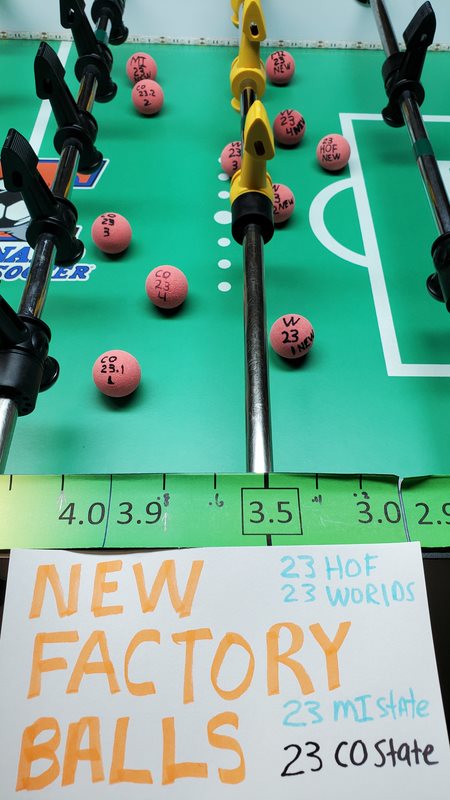This is part 2 of our series of blog posts on foosball refurbishing. Part 1 covered why foosball refurbishing is important (cost) and why it’s controversial (inconsistency). Making engineering consistent requires measurement, so in this blog post we’ll talk about what to measure and how to do it.
You can measure Tornado foosballs lots of different ways. Good variables to track are things that are easy to measure, things that change as balls see more play and become worn out, and things that are impacted by refurbishing. Rolling resistance is the best tracking variable.
| Factor | Changes with Play | Changes with Refurbishing | Easy to measure |
| Weight | no | minimal | yes |
| Diameter | no | minimal | yes |
| Bounciness | no | no | no |
| Hardness | no | no | yes |
| Roundness | yes | minimal | somewhat |
| Rolling Resistance | yes | yes | yes |
People spend a lot of time worrying about the weight and size, but it turns out this is fairly consistent (except when the ITSF 2022 World Cup used a custom ball because of production and shipping problems for standard ball.). Boise FoosWorks checked the consistency of new Tornado balls, and discovered that even factory direct balls have some size and weight variations. Refurbishing does shrink balls a bit, but not by much; we’ll cover this more in Part III of this blog post series.
| Measurement | New Balls |
| Weight | 26.32 grams ± 0.16g |
| Diameter | 34.64 mm ± 0.06mm |
Bounciness and Hardness are both fairly consistent, and don’t change with play or with refurbishing. Players would notice if balls bounced wrong, but bounciness is controlled by the material and original manufacturing process rather than the age of the ball. Hardness can be measured using a durometer. Tornado balls range from 58-62 on the Shore D Hardness Scale. Balls above 62 are probably not genuine Tornado balls.
Roundness is important, and does change with play as balls will pick up nicks and chips and flat spots. As the fuzz on the ball becomes worn down, modest irregularity in roundness or a nick can affect how true the ball rolls. This is difficult to measure, but is noticeable on the table because damaged balls wobble instead of rolling straight. Refurbishing puts new fuzz on the ball and might mask a ball being out of round, but this can’t be fixed with refurbishing. The ball should be discarded once it is out of true.
For checking whether foosball refurbishing is working properly, it turns out the main variable we care about is rolling resistance, which players sometimes call “Ball Speed.” Ball Speed is the critical variable that changes with play. As balls wear out, the fuzz on the balls packs down, they lose rolling resistance, and they tend to move faster. As the fuzz matts down, the grip or “pinch point”, where the ball becomes stuck between the player figure and the table due to static friction, changes as well. Players notice the balls are too hard to control, and this is when they should be replaced or refurbished.
This gives us a goal for a good refurbishing process. Refurbished foosballs should have the same size, weight, and speed as factory direct balls. But how can we be sure we’ve got it right?
Boise FoosWorks designed a calibrated stimpmeter to measure rolling resistance. You can see it in action when we compare a worn out ball to a new ball, as in the video below.
We tested the reliability of the stimpmeter approach by repeated measurements of rolling distance for the same ball. We found that the standard deviation of stimpmeter measurements was about 1.3 inches: not perfectly consistent. However, the difference in rolling distance between a worn out versus a new ball is much larger.
- A worn out ball will roll the full 47 inches down the table, bounce off the back wall, and keep rolling for another few inches.
- A new ball will roll 30 to 40 inches, depending on the batch. Most new balls should stop within reach of the 3 bar, and most certainly before the 2 bar.
Once we’re using a stimpmeter, we can see lots of variation in ball quality. For example, different batches of brand new Tornado balls have different rolling resistance. In the photo below, we can see the balls used at the Colorado State Championships played slower, several stopping within reach of the 5-bar. The World Championships, Michigan State Championships, and Hall of Fame Classic balls rolled to the 3-bar.

The stimpmeter is a winner for measuring foosball quality. Worn out balls roll faster and farther. A good refurbishing process should restore them to a new ball rolling speed and quality, without impacting size and weight.
Stay tuned for more reports on foosball refurbishing! Our next blog post will compare the Boise FoosWorks refurbishing process with other techniques.



